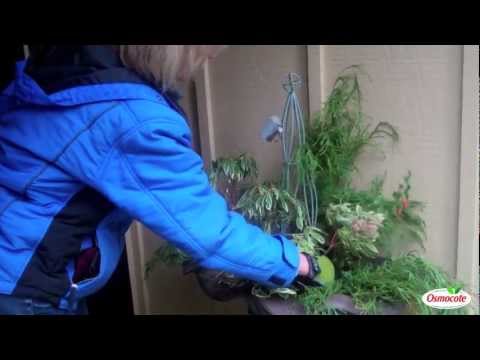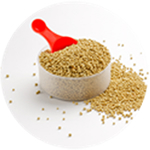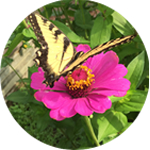The classiest and most spectacular houseplant you can grow this winter is amaryllis. Amaryllis are actually Hippeastrum, a plant that originally comes from South America. Because I especially enjoy the holidays, I like an amaryllis that blooms around Christmas, but there are others that blooms in the midst of winter. Several online specialty growers offer a large number of amaryllis in a variety of sizes, colors, styles, heights and bloom time.
There is a whole new world of winter-blooming Hippeastrum that has become synonymous with Christmas in the U.S. The fat, brown bulbs line big box stores, supermarkets, and florists’ shelves as early as mid-November. Some won’t bloom until February or even later, but others are cultivated to bloom for the Christmas holidays. They all have one thing in common: most people will call the flamboyant flowers Amaryllis.
Should you call these plants Hippeastrum or Amaryllis?
Confusion about the naming of this tropical bulb has been going on for centuries. The latest clarification comes from the 2004 book, Hippeastrum: the Gardener’s Amaryllis, by Veronica M. Read. She says that despite the extensive media coverage given to Hippeastrum in some Western European countries and in the United States since 1997, many breeders, growers, exporters, retailers and consumers continue to refer to the plant as an ‘amaryllis.’ ”
Without going into too much detail, Amaryllisoriginate in South Africa, while Hippeastrumcomes from South America. The bulbs we mistakenly call amaryllis are hybrids of the South American Hippeastrum.
Hadeco(http://www.hadecobulbs.com/) is a South African grower of Hippeastrum, bred specifically for flowering during the winter holidays. According to Hadeco Director Charles Barnhoorn, “Southern Hemisphere Hippeastrum flower naturally in October, and thus will flower naturally in the months after that, once provided a little warmth.”
Worldwide, Barnhoorn says most varieties were developed for the cut flower trade and the majority of Hippeastrum bulbs are still used in that way. “The requirements between cut flower and container Hippeastrum are very different,” he explains. “For container-production, the varieties are shorter so as not to fall over in low-light (home) conditions; they’re more prolific and quicker to flower.”
How long do you have to wait for Hippeastrum / Amaryllis to bloom?
In Hippeastrum: the Gardener’s Amaryllis, the author writes, “The number of days from planting to flowering depends on the plant’s genetic constitution, preparation given prior to purchase, and environmental and cultural conditions after planting. Four weeks from planting to flowering is considered particularly fast, five to six desirable and seven weeks acceptable for potted plants.”
Jill Fielder of Leafari says her company sources some of its amaryllis from an Israeli grower whose cultivars flower in 4-6 weeks, while other varieties take six to eight weeks, or longer. “All are propagated/grown in the same environment, so conditions are only part of the equation when looking at weeks needed to bloom,” she says. “Hippeastrumpapilio (Butterfly amaryllis) is super slow to bloom, often taking three to four months, regardless of where it’s propagated/grown. It’s just the nature of this variety.”
Depending on what the purpose of your purchase is — a gift or your own holiday decoration — stage of bloom is key. It’s not an exact science in a home environment, but a bulb with a short stem showing a plump flower bud should bloom in a few weeks as the stem elongates and the bud plumps up.
Timing
Online sources in the U.S. categorize the early bloomers as those sourced from the Southern Hemisphere, usually South Africa and/or Peru. Alternatively, the bulbs to bloom in a short period could be called Christmas-blooming. If you are trying to time your flower’s bloom within a week or two, it’s best to ask.
According to Ann Marie Rainer of Amaryllis and Caladium Bulb Co.(http://www.amaryllis.com/), the Christmas-blooming bulbs can typically flower in five weeks, depending on room temperature. “The warmer they are, the more quickly they break dormancy and send up a bloom stalk,” she says. “If you have the bulbs in hand, but want to hold them for a few weeks, they can be stored in a refrigerator to keep them from starting before you are ready.”
White Flower Farm offers a wide selection of early-and late-flowering Hippeastrum varieties. Lorraine Calder, White Flower Farm president, says, “Of all the colors now available, red is still the best seller, although double-petaled flowers are also favorites. There is something about red and the time of year.” She continues, “Peach tones are being worked on by one or two hybridizers. Customers like them but are not crazy about them.”

Hippeastrum Terra Cotta Star ® Photo by Longfield Gardens
Modern day Hippeastrum hybrids are a lot more compact, reaching no taller than 24 inches. Their predecessors were repurposed varieties from the cut flower market, and were almost impossible to keep upright. Hybrids have exploded in variety since the days of trussing up potted amaryllis. Today there are singles, doubles, outward-facing, ruffled, and bi-colored flowers; plus miniatures and multi-stemmed cultivars. Choosing just one nearly impossible.
How to grow Hippeastrum / Amaryllis (instructions provided by Longfield Garden)
- Select the right pot and use good soil.
- Amaryllis have long stems and big flowers. A heavy pot with a wide base will help the plant stay upright. Choose a pot that is about 2” wider than the bulb. If you are planting several bulbs in one container they can be planted about an inch apart.
- Use a high-quality, sterile growing mix (to avoid fungus gnats). Moisten the soil, fill the pot a little more than half full and set the bulb on top. Add more soil, leaving the top 1/3 of the bulb exposed.
- After you plant your bulbs, water well to help settle them into their pots. Then keep the soil barely moist, applying no more than ¼ cup of water per week.
- For best results, grow your amaryllis in a relatively cool room (60-65°F) with bright, indirect light. The first thing to emerge from the bulb is usually a bud. Leaves and additional stems will follow.
- Rotating the pot every few days will help keep the stems straight.
What to do with Hippeastrum / Amaryllis flowers
- Depending on the size of the bulb, you can expect one to three stems, each with three to five flowers. All of the stems may come out at once, or they may emerge over a period of two to three weeks.
- As with all fresh flowers, cool temperatures will extend their life. Amaryllis also make excellent cut flowers. Cut the stems right before the buds are ready to open and display them in a vase with greens or other seasonal blooms.
- Use scissors to clip off faded blossoms. Once the stem has finished blooming, use a knife to make a clean cut about one inch above the bulb.
How do I get Hippeastrum / Amaryllis to rebloom?
Longfield makes a good point: An amaryllis bulb costs no more than a supermarket bouquet. Yet many people find it hard to part with the bulb once the flowering season is over. If you wish, you can save the bulb and try getting it to bloom again next year. To learn more, read How to Get an Amarylllis Bulb to Rebloom
Getting what you want from your Hippeastrum / Amaryllis comes down to selection
Pay attention when ordering as to the number of bulbs you will receive and if they will arrive with a decorative pot, or as just bulbs with no planting materials. Some companies offer both large and small bulbs, the larger ones being more expensive, but produce more stems and flowers. Some high quality online Hippeastrum / Amaryllis online sources:
- Amaryllis and Caladium specifies time to bloom for each variety and has a short bloom-time category entitled “Southern Hemisphere Amaryllis.”
- Easy to Grow Bulbs offers a wide selection of Hippeastrum that bloom anywhere from five to 12 weeks. Examine each bulb’s description to learn specific bloom time.
- Leafari carries a good selection of Hippeastrum, each of which includes information about how many weeks it typically takes for bloom.
- Longfield Gardens offers a big selection of Hippeastrum, with each early-blooming variety labeled “blooms for Christmas.”
- Van Englen has a large selection of Hippeastrum, with categories clearly labeled “Christmas Flowering” along with varieties that bloom later.
- White Flower Farm offers Hippeastrum that make great gifts, as most include decorative containers. All bloom in January of February.
Modern day Hippeastrum hybrids are a lot more compact, reaching no taller than 24 inches. Their predecessors were repurposed varieties from the cut flower market, and were almost impossible to keep upright. Hybrids have exploded in variety since the days of trussing up potted amaryllis. Today’s singles, doubles, outward-facing, ruffled, and bi-colored flowers; plus miniatures and multi-stemmed cultivars; make choosing just one nearly impossible.







